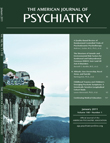Disulfiram: An Anticraving Substance?
To the Editor: We read with interest the Treatment in Psychiatry article by Bankole A. Johnson, D.Sc., M.D. (1), published in the June 2010 issue of the Journal. Hereby, we would like to briefly comment on the author's statements regarding disulfiram.
Disulfiram has been used for more than 50 years as an aversion therapeutic agent in the treatment of alcohol dependence (2). However, categorizing disulfiram as a “psychological pill” does not encompass the whole potential of the substance, since emerging evidence suggests that it also possesses anticraving properties (3). Besides its well-known mechanism of action (i.e., aldehyde dehydrogenase inhibition), disulfiram also inhibits dopamine beta-hydroxylase, leading to an increase of dopamine concentrations while decreasing concentrations of norepinephrine in the brain (4). Since dopaminergic transmission in the ventral striatal reward system is suggested to play a key role in the development of addictive disorders and craving (5, 6) and reduced activation of this system has been shown in alcohol dependence (7), cocaine dependence (8), and non-substance-related addictions such as pathological gambling (9), disulfiram could be hypothesized as a common treatment option for these disorders. In cocaine dependence, disulfiram has already shown preliminary efficacy in reducing craving and relapse rates (10). Furthermore, in a patient with alcohol dependence and comorbid pathological gambling, treatment with disulfiram led to a significant reduction in alcohol craving and urges to gamble as well as to maintenance of abstinence from both alcohol and gambling for more than 12 months (11). In alcohol dependence, most of the clinical trials conducted with disulfiram have possessed significant methodological shortcomings and have not measured changes in alcohol craving under treatment (2). Therefore, to evaluate the potential of disulfiram as an anticraving agent also in alcohol dependence, further randomized controlled trials would be needed.
1. : Medication treatment of different types of alcoholism. Am J Psychiatry 2010; 167:630–639Link, Google Scholar
2. : The status of disulfiram: a half of a century later. J Clin Psychopharmacol 2006; 26:290–302Crossref, Medline, Google Scholar
3. : Disulfiram: an old therapeutic with new applications. CNS Neurol Disord Drug Targets 2010; 9:5–12Crossref, Medline, Google Scholar
4. : Disulfiram and diethyldithiocarbamate intoxication affects the storage and release of striatal dopamine. Toxicol Appl Pharmacol 1996; 139:102–108Crossref, Medline, Google Scholar
5. : Correlation between dopamine D(2) receptors in the ventral striatum and central processing of alcohol cues and craving. Am J Psychiatry 2004; 161:1783–1789Link, Google Scholar
6. : Shared brain vulnerabilities open the way for nonsubstance addictions: Carving addiction at a new joint? Ann N Y Acad Sci 2010; 1187:294–315Crossref, Medline, Google Scholar
7. : Ventral striatal activation during reward anticipation correlates with impulsivity in alcoholics. Biol Psychiatry 2009; 66:734–742Crossref, Medline, Google Scholar
8. : Altered neural response of the appetitive emotional system in cocaine addiction: an fMRI study. Addict Biol 2010; 15:504–516Crossref, Medline, Google Scholar
9. : Pathological gambling is linked to reduced activation of the mesolimbic reward system. Nat Neurosci 2005; 8:147–148Crossref, Medline, Google Scholar
10. : Disulfiram for the treatment of cocaine dependence. Cochrane Database Syst Rev 2010:CD007024Google Scholar
11. : Disulfiram, an option for the treatment of pathological gambling?. Alcohol Alcohol 2010; 45:214–216Crossref, Medline, Google Scholar



